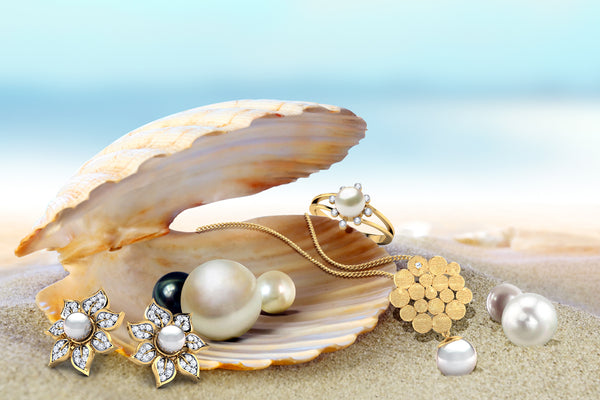What are Pearls?
The pearls you may wear in earrings and necklaces are the result of irritants under the shell of the organism. Some people think that pearls are the tears of God. Others believe they are moonlit dewdrops that fall into the sea and are devoured by oysters.

Pearls are natural gemstones created by living organisms. When a foreign body is introduced into a mussel or oyster, the animal coats the irritant with a substance called nacre, which is used to make the shell. The layers of nacre build up to form pearls.
Where Does Pearls Come From?
Natural pearls can start off with an itch, although most pearl experts now agree that "grit" is just a myth.
Nature kicks in when seeds of small substances like parasites get trapped in the shell of an oyster or mussel. Shellfish slowly deposit a layer of organic material called nacre around their source of irritation.
Nacre is made from two forms of calcium carbonate, called aragonite and calcite, which are found in the inner lining of shellfish and are often referred to as "mother of pearl." They are linked together by a small organic protein called conchlin, the same protein found in human hair and nails. Together these substances form nacre.
Over time, the shellfish's nacre develops a smooth surface around the foreign body, slowly transforming it into beautiful pearls that are unique in shape, size and color. What distinguishes one pearl from another is the shape and position of the aragonite and calcite crystals held in place by the Conchiolin.
How Long Does It Take for a Pearl to Form?
How long does it take for pearls to form after planting a stimulant? Some pearls can develop within six months. Larger pearls can take up to four years to form. This is one of several reasons why larger pearls can yield higher value.
Here’s how the different varieties of cultured pearls form…
1. How are Freshwater Pearls Formed?
They are born among freshwater mussels and belong to the family Unionidae. All freshwater pearls used in the jewelry industry today come from pearl farms.
The main mussel species responsible for making freshwater pearls are the spinnaker (triangular shell) and Hyriopsis schlegeli (pipa shell). Several tiny pieces of mantle tissue were surgically implanted into it. In response to invasive stimuli, mollusks begin to produce sacs. This is basically the secretion of the nacre around the tissue and usually lasts 2 to 7 years. In the end, it produced more than two dozen pearls.

2. How are Akoya Pearl Formed?
Unlike freshwater pearls made from mussels, Akoya pearls are born from oysters. More specifically, it is a bead-core cultured pearl produced by Pinctada fucata martensii (aka Akoya oyster).
The gonads (reproductive organs) of Akoya oysters are surgically implanted with nuclear beads, which are usually polished shell material obtained from freshwater mussels. The procedure also includes a small piece of mantle tissue from another mollusk (the donor shell). This combination helps initiate the formation of nacre sacs within the oyster, which then secrete nacre around it. The oysters are then put back into the water and grown for anywhere from a year to 18 months. When the harvest season arrives, a pearl Akoya pearl can be found in the oyster.

3. How are South Sea Pearls Formed?
Pinctada maxima is a marine bivalve mollusk belonging to the oyster family and responsible for the production of South Sea pearls. It is also commonly known as the South Sea Oyster.
Similar to the harvesting process for Akoya pearls, this sophisticated method involves surgically growing a perfectly round bead nucleus.It is inserted safely into the gonads of the oyster. A small piece of approximately 1.0 mm of mantle tissue from a different donor oyster was also included. After the surgical incision, the oysters have time to heal and be returned to their natural environment. Over the course of two years, a thick layer of nacre is deposited around the core, giving birth to a beautiful South Sea pearl.
4. How are Tahitian Pearls Formed?
This extremely beautiful and rare pearl variety was created by Pinctada margaritifera (commonly known as black-lipped pearl oyster).
Parting Instructions:
So now that you've learned the hard way your pearls are born, we're sure you love your custom pearl jewelry more than ever. Whether the pearl was cultured inside a mollusk or its formation was initiated by nature itself, each resulting piece of jewelry is a sacred work of art.
Also Read: 7 Unique Pearl Jewelry Picks for Her June Birthday



